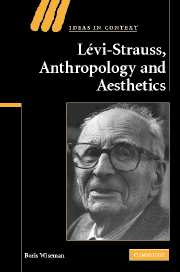Book contents
- Frontmatter
- Contents
- List of illustrations
- Acknowledgements
- Introduction: ethno-aesthetics
- 1 The reconciliation
- 2 Art and the logic of sensible qualities
- 3 The work of art as a system of signs
- 4 Structuralism, Symbolist poetics and abstract art
- 5 The anthropologist as art critic
- 6 Nature, culture, chance
- 7 From myth to music
- 8 Lévi-Strauss's mytho-poem
- Conclusion: between concept and metaphor
- References
- Index
- IDEAS IN CONTEXT
5 - The anthropologist as art critic
Published online by Cambridge University Press: 27 October 2009
- Frontmatter
- Contents
- List of illustrations
- Acknowledgements
- Introduction: ethno-aesthetics
- 1 The reconciliation
- 2 Art and the logic of sensible qualities
- 3 The work of art as a system of signs
- 4 Structuralism, Symbolist poetics and abstract art
- 5 The anthropologist as art critic
- 6 Nature, culture, chance
- 7 From myth to music
- 8 Lévi-Strauss's mytho-poem
- Conclusion: between concept and metaphor
- References
- Index
- IDEAS IN CONTEXT
Summary
There are scattered throughout Lévi-Strauss's writings a number of comments – sometimes developed into essay-length studies – on Western art and artists. In particular, Lévi-Strauss has expressed his views on three of the most important movements to have shaped the evolution of modern European art: Impressionism, Cubism and abstract art. He has also written about individual artists: the German painter and illustrator of children's books Anita Albus (the cover of the French edition of The View from Afar is by her), and major figures such as Poussin, Cézanne and Picasso. In what follows, I will be concerned with Lévi-Strauss's writings on Western art. What does Lévi-Strauss value in Western art? According to what criteria does he judge it? How does he relate ‘primitive’ and Western art? These are the questions that I will be addressing in this chapter in which I propose to examine the ideas of the anthropologist-turned-art-critic. The specificity of his point of view, which is at once an advantage and a disadvantage, is a certain distance on the historical developments that concern the traditional art historian, developments that he apprehends, as it were, from the outside, in other words in their relationship to the artistic practices of ‘exotic’ societies.
At first, Lévi-Strauss seems to express conflicting views about Western art. On the one hand, he is critical of the great European tradition of figurative painting.
- Type
- Chapter
- Information
- Levi-Strauss, Anthropology, and Aesthetics , pp. 119 - 134Publisher: Cambridge University PressPrint publication year: 2007



